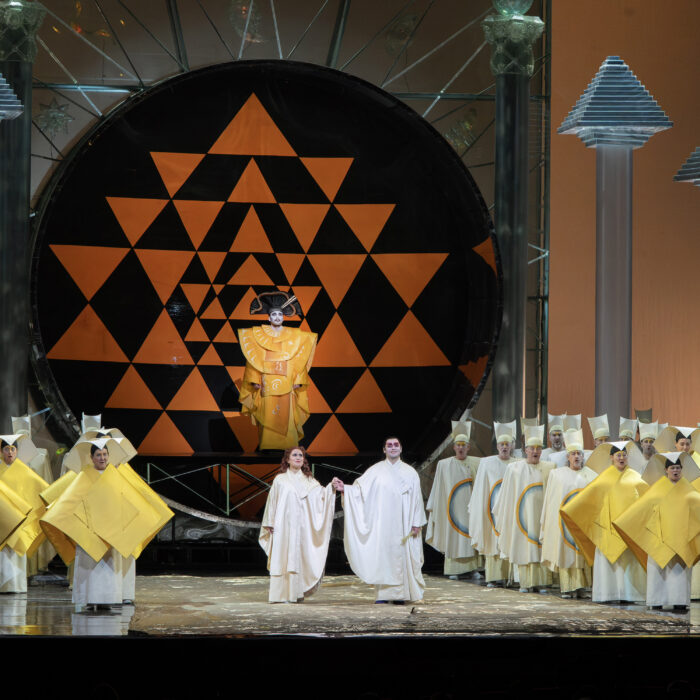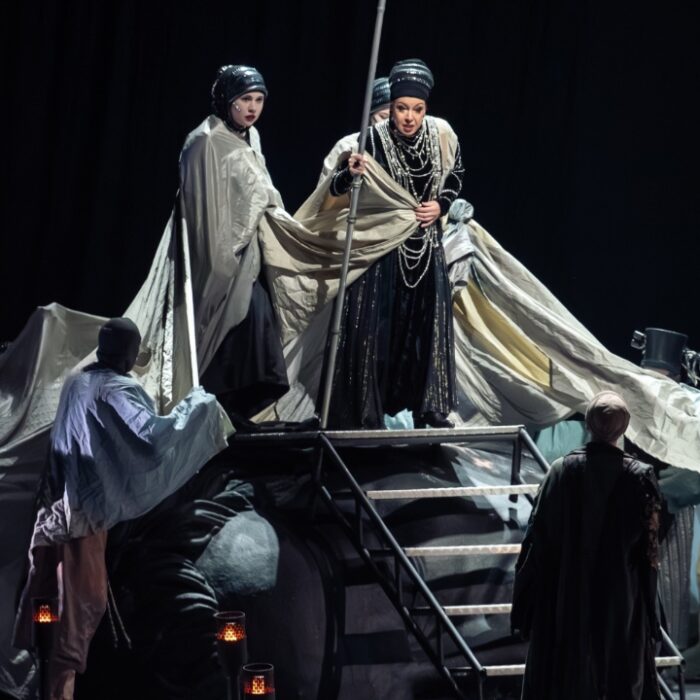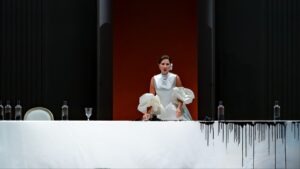
Teatro Municipale di Piacenza 2024-25 Review: La Traviata
By Bernardo Gaitan(Photo: © Gianni Cravedi & ® Luca Attilii)
The Teatro Municipale di Piacenza presented an ambitious project dedicated to Giuseppe Verdi: “Rigoletto,” “Il trovatore,” and “La Traviata,” brought together in a single cycle under the title “Popular Trilogy,” all performed within the same week. Although not originally conceived by Verdi as a unified set, these three operas represent the composer’s artistic maturity and his deepest bond with Italian musical theatre. Supported by a substantial contribution from the Italian Ministry of Culture, this autumn project offered a contemporary reading of three universally renowned titles, reaffirming Piacenza’s role as a Verdian reference point, located just 30 kilometers from Busseto, Verdi’s birthplace.
For all three productions, Roberto Catalano signed the stage direction, proposing a minimalist and conceptual approach focused on the human and symbolic dimension of “curse” and family tragedy as the unifying thread among the three operas. He explains in the program notes that Rigoletto loses his daughter, Azucena kills her son, and Germont, to spare his daughter an unhappy fate, demands a sacrifice from “La Traviata’s” heroine. Catalano views the trilogy as “one story divided into several parts,” where the parents experience indescribable pain: the suffering of their children echoing the cry of wounded fathers who are never heard.

(Photo: © Gianni Cravedi & ® Luca Attilii)
Production Details
This review refers to the final performance of the cycle, “La Traviata,” on November 9. In this production, the regista emphasized Violetta’s suffering, Alfredo’s obstinacy, and Germont’s redemption. To underline the little time the heroine has left, Catalano personified death as a macabre mime, portrayed by Marco Caudera, who circles obsessively around her, reminding her that her end is near.
The stage design, common to all three operas and created by Mariana Moreira, consisted of an elegant neoclassical wall: a neutral, mutable environment in which the dramatic essence of each work intertwines while retaining its individuality. A nearly empty stage was filled with just a few symbolic elements: candlesticks, an armchair, a divan, a table, and a bed, simple yet meaningful, providing coherence and atmosphere. Veronica Pattuelli’s costumes contributed modern elegance and restraint: Violetta appeared always dressed in pure white, contrasting with the black suits of the male protagonists and the chorus, reinforcing the symbolism of purity and death. Silvia Vacca’s lighting completed a clean and visually cohesive aesthetic, precisely highlighting the emotional and spatial focus of the drama.
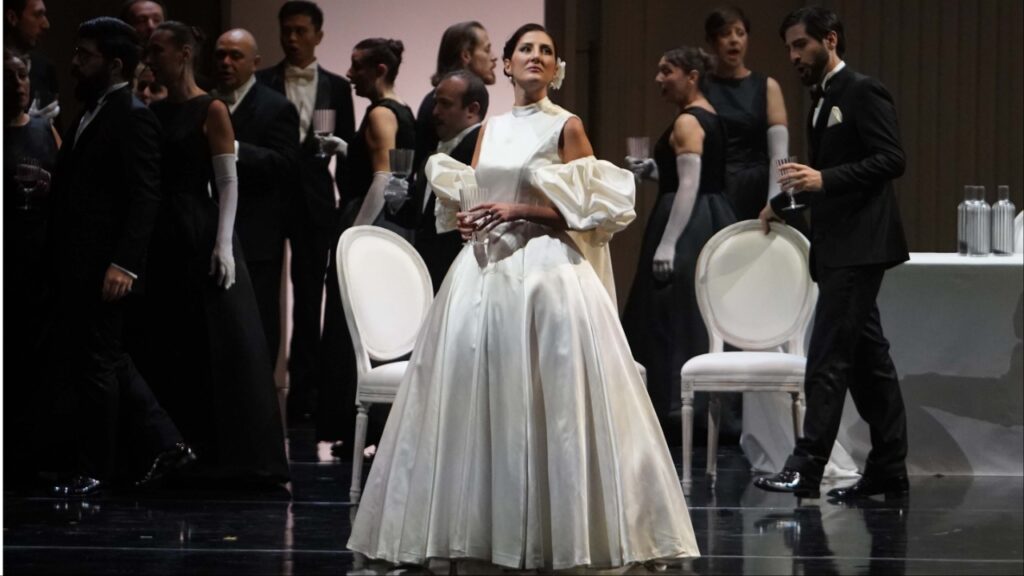
(Photo: © Gianni Cravedi & ® Luca Attilii)
Musical Highlights
The musical direction of Francesco Lanzillotta was distinguished by its rigorous adherence to Verdian style, enhanced by a number of highly successful personal touches. The conductor delivered a reading that balanced fidelity with interpretative exploration, highlighting the expressive nuances of the score. He maintained dramatic momentum with admirable orchestral transparency. From the famous Prelude, it was evident that this would be a thoughtful and carefully prepared interpretation. Lanzillotta skillfully controlled dynamics to ensure the singers were never overpowered, while offering inventive solutions in tempo and phrasing. The Orchestra Sinfonica di Milano, in its first collaboration with the Piacenza theatre, did not always respond with precision to the conductor’s demands and at times revealed noticeable tuning issues. Nevertheless, the purely orchestral passages and ensemble moments displayed great vigor and emotion. The Coro del Teatro Municipale di Piacenza, excellently prepared by Corrado Casati, once again delivered a homogeneous, solid, and musically refined performance, along with a convincing stage presence.
The cast, shared among the three productions, gathered performers with considerable experience in Verdian repertoire. In the title role, Maria Novella Malfatti offered a Violetta of great lyricism and vocal purity, marked by expressive phrasing, a beautiful timbre, clean coloratura, and firm high notes. Remarkably, during the same week the soprano also sang the roles of Gilda and Leonora. Her Violetta combined elegance and emotional depth, particularly in a touching “Addio del passato” and a brilliant “Sempre libera.”
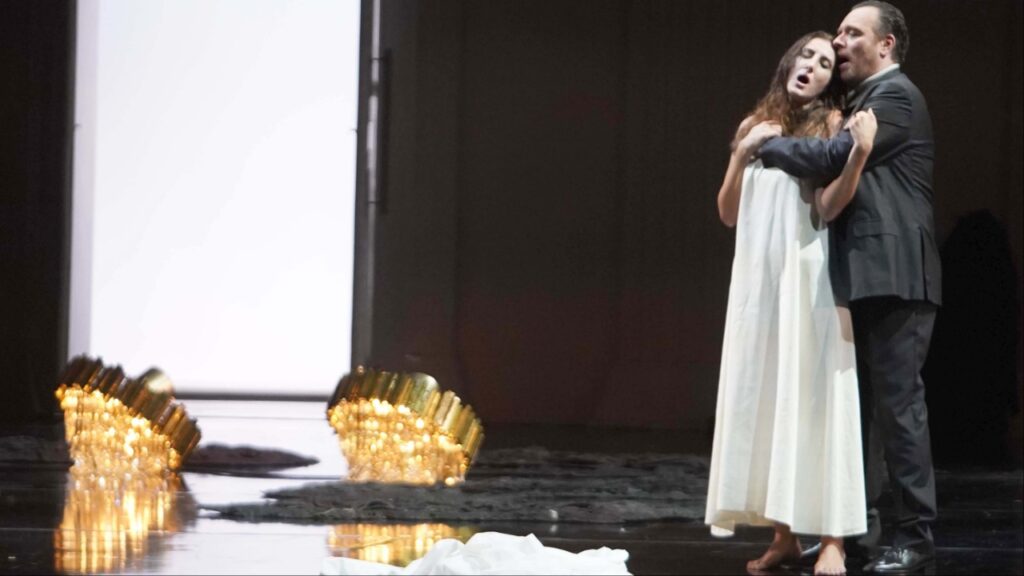
(Photo: © Gianni Cravedi & ® Luca Attilii)
Francesco Meli took on the role of Alfredo Germont (as well as the Duke of Mantua and Manrico in the other two operas), displaying a refined vocal line and expressive intent, his bright, resonant voice shining throughout the performance. Visibly affected by a strong cough, the tenor nonetheless faced the evening with professionalism. The difficulty was most apparent in “Dei miei bollenti spiriti,” yet, with admirable resolve, Meli refused to abandon the stage and managed to complete the demanding cabaletta, “O mio rimorso!,” despite his condition. His duets with Malfatti, “Un dì, felice” and “Parigi, o cara,” were intense and passionate, both vocally and dramatically.
Baritone Ernesto Petti as Giorgio Germont, who alternated the roles of Conte di Luna and “Rigoletto” with Luca Salsi, brought weight and authority to the character. Although not particularly emotive as an actor, he compensated with a beautiful, rounded voice, firm upper register, and well-schooled middle range. His duet with Violetta was warmly received, to the point that a few elderly ladies in the audience shouted “Bis!” after his performance of “Di Provenza il mar, il suol.”
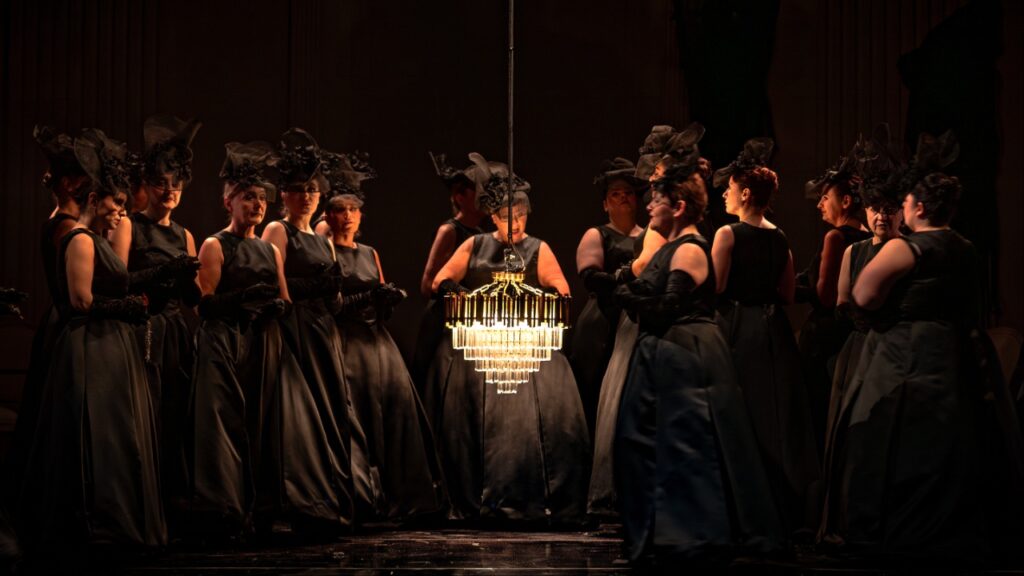
(Photo: © Gianni Cravedi & ® Luca Attilii)
The cast was completed by a group of young Italian singers, mostly under 35, who added freshness, enthusiasm, and commitment to the production. Irene Savignano portrayed an elegant Flora Bervoix, while Francesca Palitti gave presence and dignity to Annina. Simone Fenotti was a well-poised Gastone, and Davide Maria Sabatino offered a solid Barone Douphol. Nicola Zambon lent distinction to the Marchese d’Obigny, while Omar Cepparolli portrayed an authoritative Dottor Grenvil. Finally, Lorenzo Sivelli (Giuseppe) and Massimo Pagano (Flora’s servant and the commissioner) efficiently completed this young and promising ensemble.
The Verdian Trilogy of Piacenza thus established itself as one of the most remarkable and engaging initiatives of the current Italian opera season. The warm applause and enthusiastic ovations at the end of the performance sealed the success of this ambitious and artistically rewarding project.


